Nitrites Detection with Sensors Processed via Matrix-Assisted Pulsed Laser Evaporation
Abstract
:1. Introduction
2. Materials and Methods
2.1. Laser Processing of the Sensing Materials for the Working Electrode
2.2. Characterization of the Sensing Coatings Processed by MAPLE
3. Results and Discussions
3.1. Surface Chemistry Investigations: FTIR, Contact Angle, and Surface Free Measurements
3.2. Morphological Investigations
3.3. Voltammetric Response of Nitrite at CNT-Chit-FePc Modified C-SPE
4. Conclusions
Supplementary Materials
Author Contributions
Funding
Institutional Review Board Statement
Informed Consent Statement
Data Availability Statement
Conflicts of Interest
References
- Ge, L.; Han, Z.; Gao, Y.-Q.; Zhou, C.-J.; Wang, D.-H.; Ma, Y.-Z.; Liang, C.-G. Sodium nitrite negatively affects reproductive ability and offspring survival in female mice. Toxicology 2019, 427, 152284. [Google Scholar] [CrossRef] [PubMed]
- Huang, C.-P.; Wang, H.-W.; Chiu, P.-C. Nitrate reduction by metallic iron. Water Res. 1998, 32, 2257–2264. [Google Scholar] [CrossRef]
- World Health Organization. Guidelines for Drinking-Water Quality: Recommendations; World Health Organization: Geneva, Switzerland, 2004. [Google Scholar]
- Li, X.; Ping, J.; Ying, Y. Recent developments in carbon nanomaterial-enabled electrochemical sensors for nitrite detection. TrAC Trends Anal. Chem. 2019, 113, 1–12. [Google Scholar] [CrossRef]
- Xu, X.; Li, C.-H.; Zhang, H.; Guo, X.-M. Construction of Electrochemical and Photoelectrochemical Sensing Platform Based on Porphyrinic Metal-Organic Frameworks for Determination of Ascorbic Acid. Nanomaterials 2022, 12, 482. [Google Scholar] [CrossRef]
- Soulis, D.; Trigazi, M.; Tsekenis, G.; Chandrinou, C.; Klinakis, A.; Zergioti, I. Facile and Low-Cost SPE Modification Towards Ultra-Sensitive Organophosphorus and Carbamate Pesticide Detection in Olive Oil. Molecules 2020, 25, 4988. [Google Scholar] [CrossRef]
- Bonciu, A.F.; Filipescu, M.; Voicu, S.I.; Lippert, T.; Palla-Papavlu, A. Facile Fabrication of Hybrid Carbon Nanotube Sensors by Laser Direct Transfer. Nanomaterials 2021, 11, 2604. [Google Scholar] [CrossRef]
- Afkhami, A.; Soltani-Felehgari, F.; Madrakian, T.; Ghaedi, H. Surface decoration of multi-walled carbon nanotubes modified carbon paste electrode with gold nanoparticles for electro-oxidation and sensitive determination of nitrite. Biosens. Bioelectron. 2013, 51, 379–385. [Google Scholar] [CrossRef]
- Thirumalraj, B.; Palanisamy, S.; Chen, S.-M.; Zhao, D.-H. Amperometric detection of nitrite in water samples by use of electrodes consisting of palladium-nanoparticle-functionalized multi-walled carbon nanotubes. J. Colloid Interface Sci. 2016, 478, 413–420. [Google Scholar] [CrossRef]
- Zhang, Y.; Nie, J.; Wei, H.; Xu, H.; Wang, Q.; Cong, Y.; Tao, J.; Chu, L.; Zhou, Y.; Wu, X. Electrochemical detection of nitrite ions using Ag/Cu/MWNT nanoclusters electrodeposited on a glassy carbon electrode. Sens. Actuators B Chem. 2018, 258, 1107–1116. [Google Scholar] [CrossRef]
- Wang, C.; Yuan, R.; Chai, Y.; Chen, S.; Zhang, Y.; Hu, F.; Zhang, M. Non-covalent iron(III)-porphyrin functionalized multi-walled carbon nanotubes for the simultaneous determination of ascorbic acid, dopamine, uric acid and nitrite. Electrochim. Acta 2011, 62, 109–115. [Google Scholar] [CrossRef]
- Karrat, A.; Amine, A. Recent Advances in Chitosan-Based Electrochemical Sensors and Biosensors. Arab. J. Chem. Environ. Res. 2020, 7, 66–93. [Google Scholar]
- Ryu, H.; Thompson, D.; Huang, Y.; Li, B.; Lei, Y. Electrochemical sensors for nitrogen species: A review. Sens. Actuators Rep. 2020, 2, 100022. [Google Scholar] [CrossRef]
- Bibi, S.; Zaman, M.I.; Niaz, A.; Rahim, A.; Nawaz, M.; Arian, M.B. Voltammetric determination of nitrite by using a multiwalled carbon nanotube paste electrode modified with chitosan-functionalized silver nanoparticles. Mikrochim. Acta 2019, 186, 595. [Google Scholar] [CrossRef] [PubMed]
- Li, S.; Qu, J.; Wang, Y.; Qu, J.; Wang, H. A novel electrochemical sensor based on carbon nanoparticle composite films for the determination of nitrite and hydrogen peroxide. Anal. Methods 2016, 8, 4204–4210. [Google Scholar] [CrossRef]
- Bai, Z.; Zhou, C.; Gao, N.; Pang, H.; Ma, H. A chitosan–Pt nanoparticles/carbon nanotubes-doped phosphomolybdate nanocomposite as a platform for the sensitive detection of nitrite in tap water. RSC Adv. 2015, 6, 937–946. [Google Scholar] [CrossRef]
- Wang, T.; Xu, X.; Wang, C.; Li, Z.; Li, D. A Novel Highly Sensitive Electrochemical Nitrite Sensor Based on a AuNPs/CS/Ti3C2 Nanocomposite. Nanomaterials 2022, 12, 397. [Google Scholar] [CrossRef]
- Wang, T.; Wang, C.; Xu, X.; Li, Z.; Li, D. One-Step Electrodeposition Synthesized Aunps/Mxene/ERGO for Selectivity Nitrite Sensing. Nanomaterials 2021, 11, 1892. [Google Scholar] [CrossRef]
- Xian, H.; Wang, P.; Zhou, Y.; Lu, Q.; Wu, S.; Li, Y.; Wang, L. Electrochemical determination of nitrite via covalent immobilization of a single-walled carbon nanotubes and single stranded deoxyribonucleic acid nanocomposite on a glassy carbon electrode. Mikrochim. Acta 2010, 171, 63–69. [Google Scholar] [CrossRef]
- Yang, S.; Xia, B.; Zeng, X.; Luo, S.; Wei, W.; Liu, X. Fabrication of DNA functionalized carbon nanotubes/Cu2+ complex by one-step electrodeposition and its sensitive determination of nitrite. Anal. Chim. Acta 2010, 667, 57–62. [Google Scholar] [CrossRef]
- Dumitrescu, L.N.; Ionita, E.-R.; Birjega, R.; Lazea-Stoyanova, A.; Ionita, M.-D.; Epurescu, G.; Banici, A.-M.; Brajnicov, S.; Andrei, F.; Matei, A. Kaolinite Thin Films Grown by Pulsed Laser Deposition and Matrix Assisted Pulsed Laser Evaporation. Nanomaterials 2022, 12, 546. [Google Scholar] [CrossRef]
- Yang, S.; Zhang, J. Matrix-Assisted Pulsed Laser Evaporation (MAPLE) technique for deposition of hybrid nanostructures. Front. Nanosci. Nanotechnol. 2017, 3, 1–9. [Google Scholar] [CrossRef] [Green Version]
- Palla-Papavlu, A.; Dinca, V.; Filipescu, M.; Dinescu, M. Matrix-Assisted Pulsed Laser Evaporation of Organic Thin Films: Applications in Biology and Chemical Sensors. In Laser Ablation–From Fundamentals to Applications; Itina, T.E., Ed.; IntechOpen: London, UK, 2017; ISBN 978-953-51-3699-6. [Google Scholar]
- Ferreira Calvete, M.J.; Hanack, M. Symmetrically and Unsymmetrically Substituted Phthalocyanines. In Materials Syntheses: A Practical Guide; Schubert, U., Hüsing, N., Laine, R.M., Eds.; Springer: Vienna, Austria, 2008; pp. 217–225. ISBN 978-3-211-75125-1. [Google Scholar]
- DiChristina, T.J. Effects of nitrate and nitrite on dissimilatory iron reduction by Shewanella putrefaciens 200. J. Bacteriol. 1992, 174, 1891–1896. [Google Scholar] [CrossRef] [PubMed] [Green Version]
- Craciun, C.; Filipescu, M.; Palla-Papavlu, A.; Brajnicov, S.; Tozar, T.; Scheaua, F.; Bonciu, A.; Nedelcut, F.; Dinescu, M. Sensing Membranes based on CNT Nanocomposites Processing for Air and Water Monitoring. In Proceedings of the 2021 International Workshop on Metrology for the Sea; Learning to Measure Sea Health Parameters (MetroSea), Reggio Calabria, Italy, 4–6 October 2021; pp. 183–188. [Google Scholar] [CrossRef]
- Zeng, Z.; Fang, X.; Miao, W.; Liu, Y.; Maiyalagan, T.; Mao, S. Electrochemically Sensing of Trichloroacetic Acid with Iron(II) Phthalocyanine and Zn-Based Metal Organic Framework Nanocomposites. ACS Sens. 2019, 4, 1934–1941. [Google Scholar] [CrossRef] [PubMed]
- Kaelble, D.H. Dispersion-polar surface tension properties of organic solids. J. Adhes. 1970, 2, 66–81. [Google Scholar] [CrossRef]
- Owens, D.K.; Wendt, R.C. Estimation of the surface free energy of polymers. J. Appl. Polym. Sci. 1969, 13, 1741–1747. [Google Scholar] [CrossRef]
- Habenicht, G. Kleben der Kunststoffe und weiterer nichtmetallischer Werkstoffe. In Kleben: Grundlagen, Technologie, Anwendungen; Habenicht, G., Ed.; Springer: Berlin/Heidelberg, Germany, 1997; pp. 583–648. ISBN 978-3-662-08087-0. [Google Scholar]
- Fernandes Queiroz, M.; Melo, K.R.T.; Sabry, D.A.; Sassaki, G.L.; Rocha, H.A.O. Does the Use of Chitosan Contribute to Oxalate Kidney Stone Formation? Mar. Drugs 2014, 13, 141–158. [Google Scholar] [CrossRef]
- Shanmugam, A.; Kathiresan, K.; Nayak, L. Preparation, characterization and antibacterial activity of chitosan and phosphorylated chitosan from cuttlebone of Sepia kobiensis (Hoyle, 1885). Biotechnol. Rep. 2015, 9, 25–30. [Google Scholar] [CrossRef] [Green Version]
- Neamtu, M.; Nadejde, C.; Brinza, L.; Dragos, O.; Gherghel, D.; Paul, A. Iron phthalocyanine-sensitized magnetic catalysts for BPA photodegradation. Sci. Rep. 2020, 10, 5376. [Google Scholar] [CrossRef]
- Kim, U.J.; Furtado, C.A.; Liu, X.; Chen, G.; Eklund, P.C. Raman and IR Spectroscopy of Chemically Processed Single-Walled Carbon Nanotubes. J. Am. Chem. Soc. 2005, 127, 15437–15445. [Google Scholar] [CrossRef]
- Bantignies, J.-L.; Sauvajol, J.-L.; Rahmani, A.; Flahaut, E. Infrared-active phonons in carbon nanotubes. Phys. Rev. B 2006, 74, 195425. [Google Scholar] [CrossRef] [Green Version]
- Ţucureanu, V.; Matei, A.; Avram, A.M. FTIR Spectroscopy for Carbon Family Study. Crit. Rev. Anal. Chem. 2016, 46, 502–520. [Google Scholar] [CrossRef] [PubMed]
- Long, D.; Wu, G.; Zhu, G. Noncovalently Modified Carbon Nanotubes with Carboxymethylated Chitosan: A Controllable Donor-Acceptor Nanohybrid. Int. J. Mol. Sci. 2008, 9, 120–130. [Google Scholar] [CrossRef] [PubMed] [Green Version]
- Xie, Y.; Soh, A. Investigation of non-covalent association of single-walled carbon nanotube with amylose by molecular dynamics simulation. Mater. Lett. 2005, 59, 971–975. [Google Scholar] [CrossRef]
- Gurevitch, I.; Srebnik, S. Monte Carlo simulation of polymer wrapping of nanotubes. Chem. Phys. Lett. 2007, 444, 96–100. [Google Scholar] [CrossRef]
- Iamsamai, C.; Hannongbua, S.; Ruktanonchai, U.; Soottitantawat, A.; Dubas, S. The effect of the degree of deacetylation of chitosan on its dispersion of carbon nanotubes. Carbon 2010, 48, 25–30. [Google Scholar] [CrossRef]
- Almeida, E.V.R.; Frollini, E.; Castellan, A.; Coma, V. Chitosan, sisal cellulose, and biocomposite chitosan/sisal cellulose films prepared from thiourea/NaOH aqueous solution. Carbohydr. Polym. 2010, 80, 655–664. [Google Scholar] [CrossRef]
- Chen, F.; Shi, X.; Chen, X.; Chen, W. An iron (II) phthalocyanine/poly(vinylidene fluoride) composite membrane with antifouling property and catalytic self-cleaning function for high-efficiency oil/water separation. J. Membr. Sci. 2018, 552, 295–304. [Google Scholar] [CrossRef]
- Bonciu, A.; Vasilescu, A.; Dinca, V.; Peteu, S.F. Interfaces obtained by MAPLE for chemical and biosensors applications. Sens. Actuators Rep. 2021, 3, 100040. [Google Scholar] [CrossRef]
- Wang, Y.; Yeow, J.T.W. A Review of Carbon Nanotubes-Based Gas Sensors. J. Sens. 2009, 2009, 493904. [Google Scholar] [CrossRef]
- Wu, P.K.; Fitz-Gerald, J.; Pique, A.; Chrisey, D.; McGill, R. Deposition of Nanotubes and Nanotube Composites Using Matrix-Assisted Pulsed Laser Evaporation. MRS Proc. 2000, 617, 23. [Google Scholar] [CrossRef] [Green Version]
- Zhang, J.; Wang, Q.; Wang, L.; Wang, A. Manipulated dispersion of carbon nanotubes with derivatives of chitosan. Carbon 2007, 45, 1917–1920. [Google Scholar] [CrossRef]
- Lu, L.; Hu, Y.; Chang, C.; Chen, W. Carbon Nanotubes Engineering Assisted by Natural Biopolymers; IntechOpen: London, UK, 2011; ISBN 978-953-307-498-6. [Google Scholar]
- Rose, O.; Bonciu, A.; Marascu, V.; Matei, A.; Liu, Q.; Rusen, L.; Dinca, V.; Dinu, C. Thin Films of Metal-Organic Framework Interfaces Obtained by Laser Evaporation. Nanomaterials 2021, 11, 1367. [Google Scholar] [CrossRef] [PubMed]
- Jiang, L.; Wang, R.; Li, X.; Jiang, L.; Lu, G. Electrochemical oxidation behavior of nitrite on a chitosan-carboxylated multiwall carbon nanotube modified electrode. Electrochem. Commun. 2005, 7, 597–601. [Google Scholar] [CrossRef]
- Shrivastava, A.; Gupta, V.B. Methods for the determination of limit of detection and limit of quantitation of the analytical methods. Chron. Young Sci. 2011, 2, 21–25. [Google Scholar] [CrossRef]
- Lim, S.-H.; Hudson, S.M. Synthesis and Antimicrobial Activity of a Water-Soluble Chitosan Derivative with a Fiber-Reactive Group. Carbohydr. Res. 2004, 339, 313–319. [Google Scholar] [CrossRef]
- Song, C.; Yu, H.; Zhang, M.; Yang, Y.; Zhang, G. Physicochemical Properties and Antioxidant Activity of Chitosan from the Blowfly Chrysomya megacephala Larvae. Int. J. Biol. Macromol. 2013, 60, 347–354. [Google Scholar] [CrossRef]
- Branca, C.; Frusteri, F.; Magazù, V.; Mangione, A. Characterization of Carbon Nanotubes by TEM and Infrared Spectroscopy. J. Phys. Chem. B 2004, 108, 3469–3473. [Google Scholar] [CrossRef]
- Hussain, S.; Jha, P.; Chouksey, A.; Raman, R.; Islam, S.S.; Islam, T.; Choudhary, P.K. Spectroscopic Investigation of Modified Single Wall Carbon Nanotube (SWCNT). J. Modern Phys. 2011, 2, 538–543. [Google Scholar] [CrossRef] [Green Version]
- Jain, S.M.; Cesano, F.; Scarano, D.; Edvinsson, T. Resonance Raman and IR Spectroscopy of Aligned Carbon Nanotube Arrays with Extremely Narrow Diameters Prepared with Molecular Catalysts on Steel Substrates. Phys. Chem. Chem. Phys. 2017, 19, 30667–30674. [Google Scholar] [CrossRef] [Green Version]
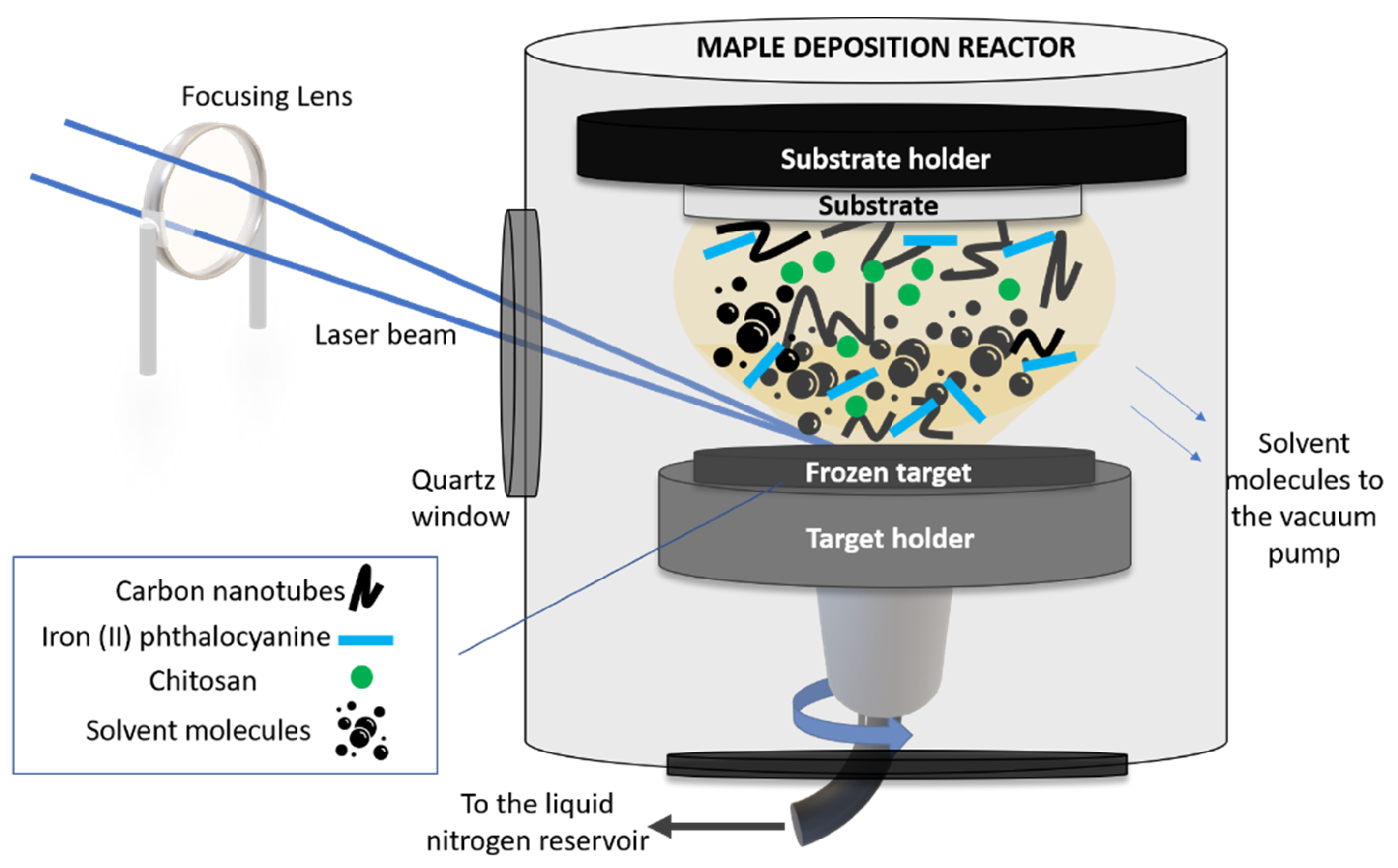

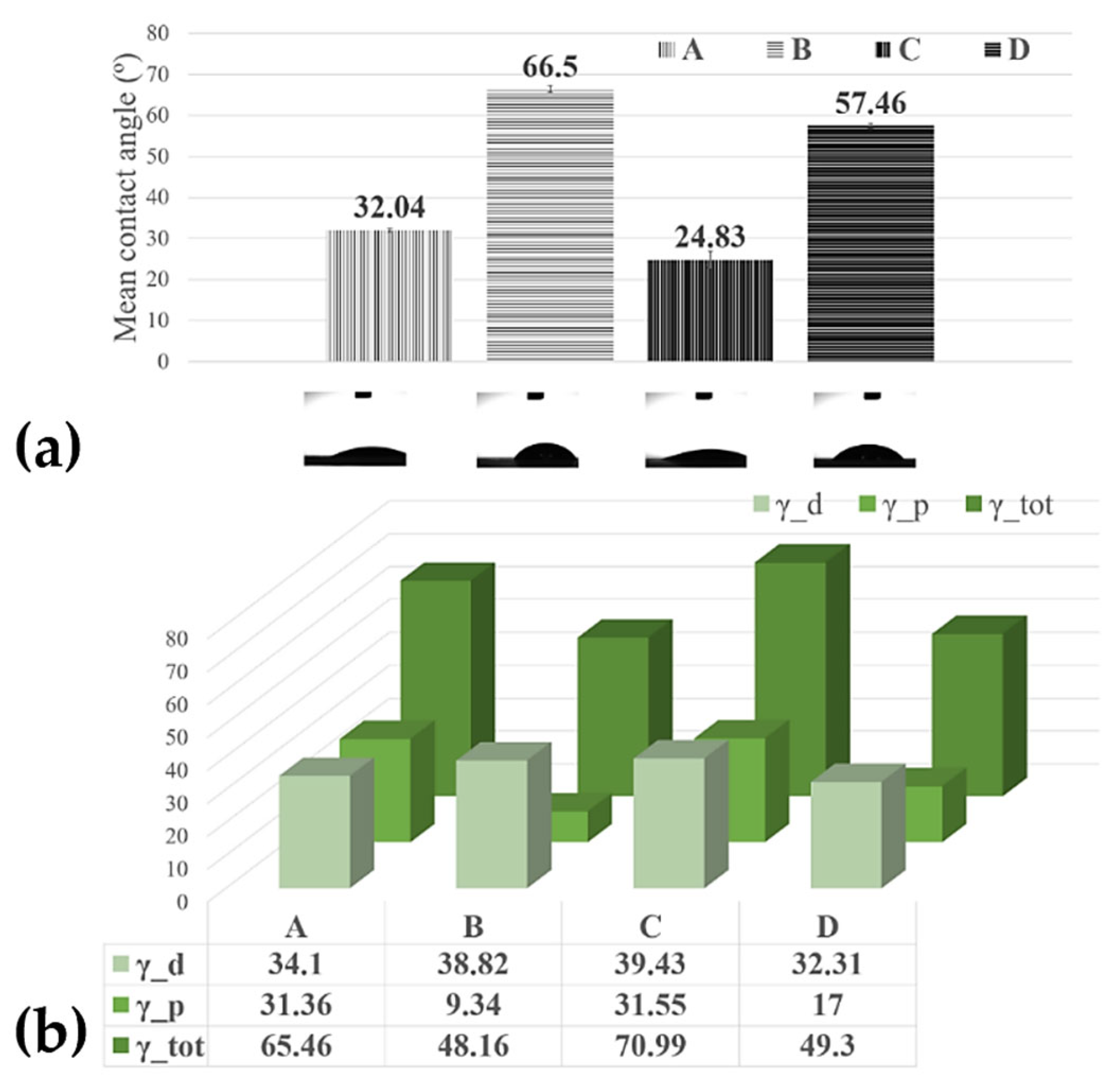
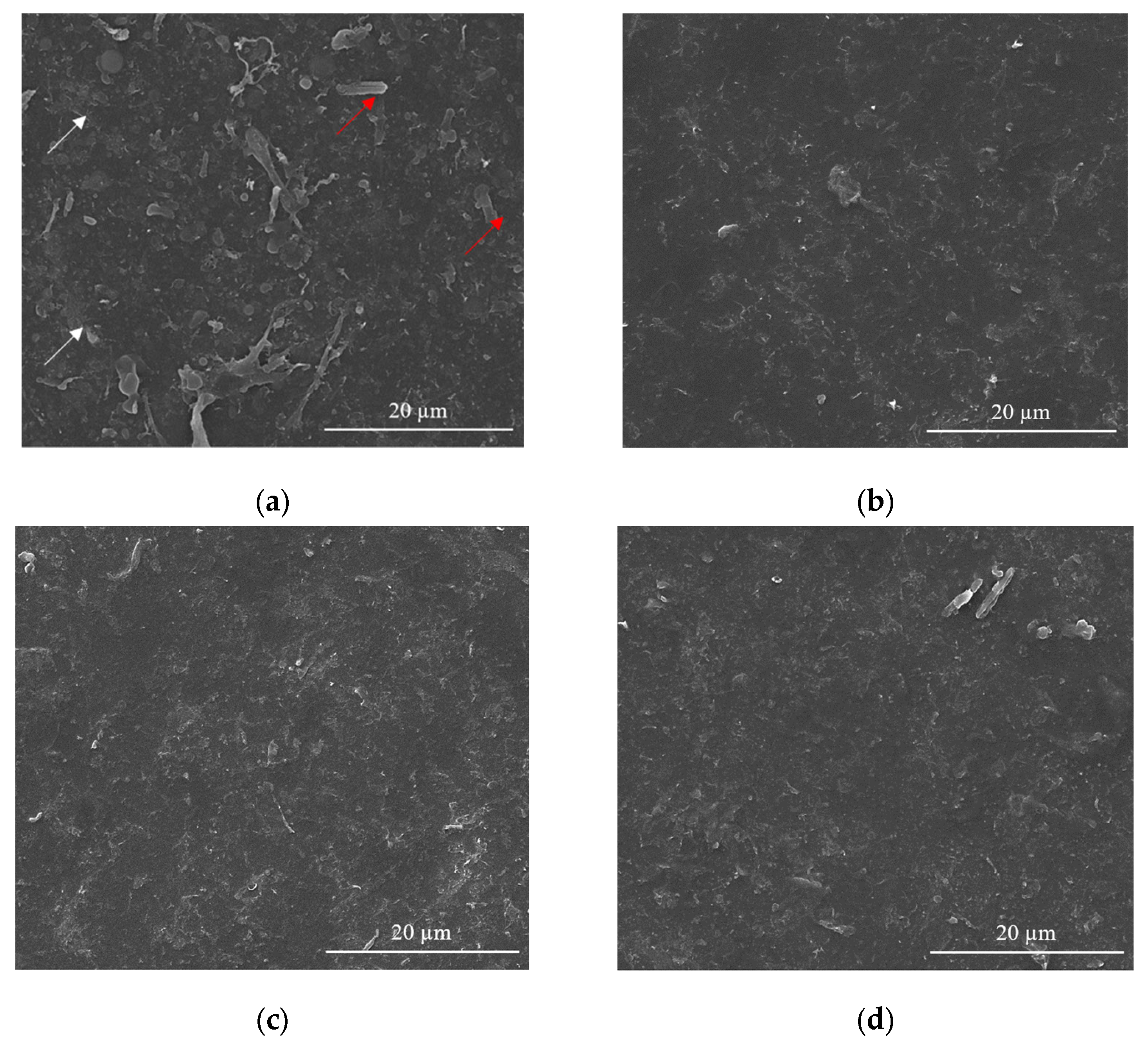

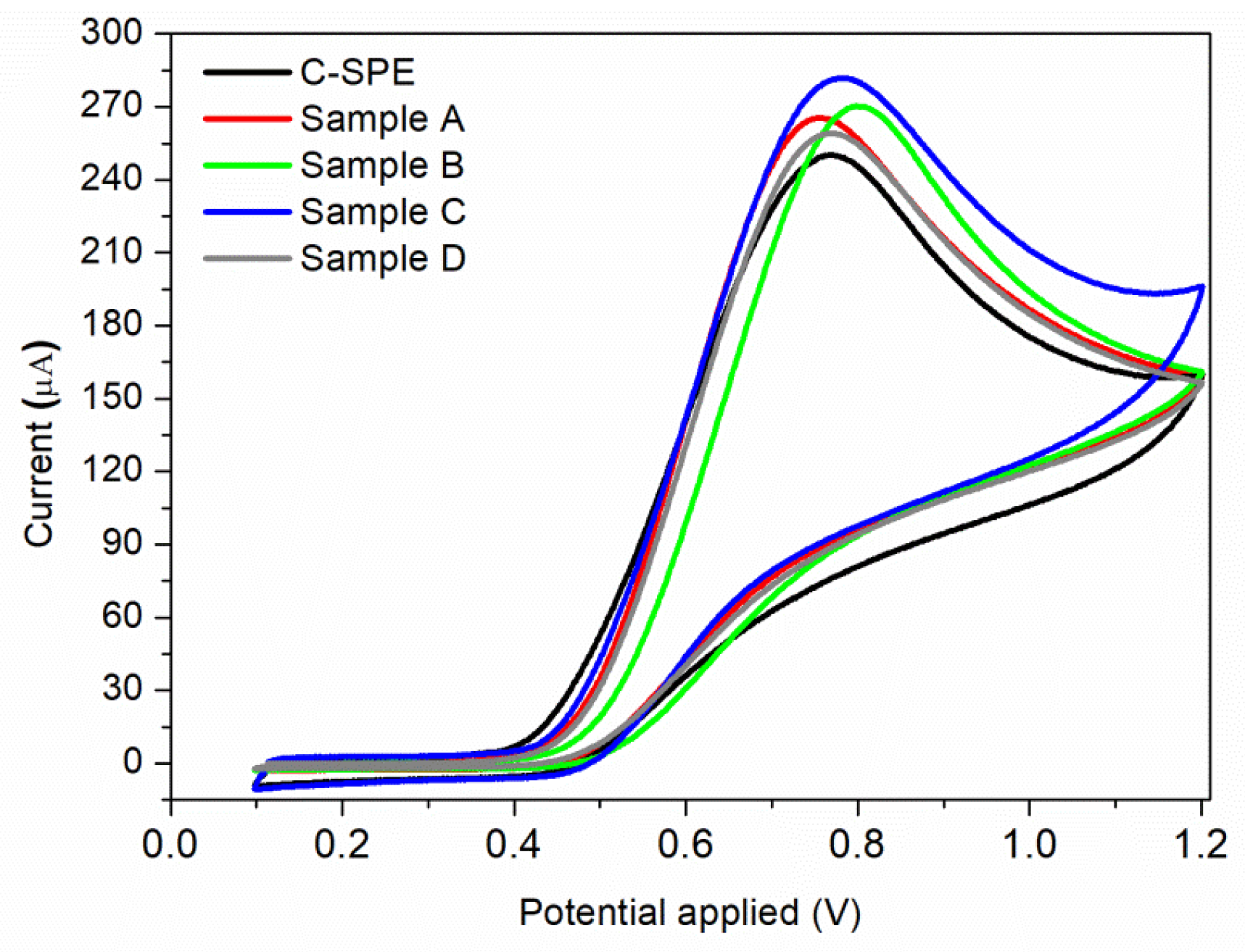

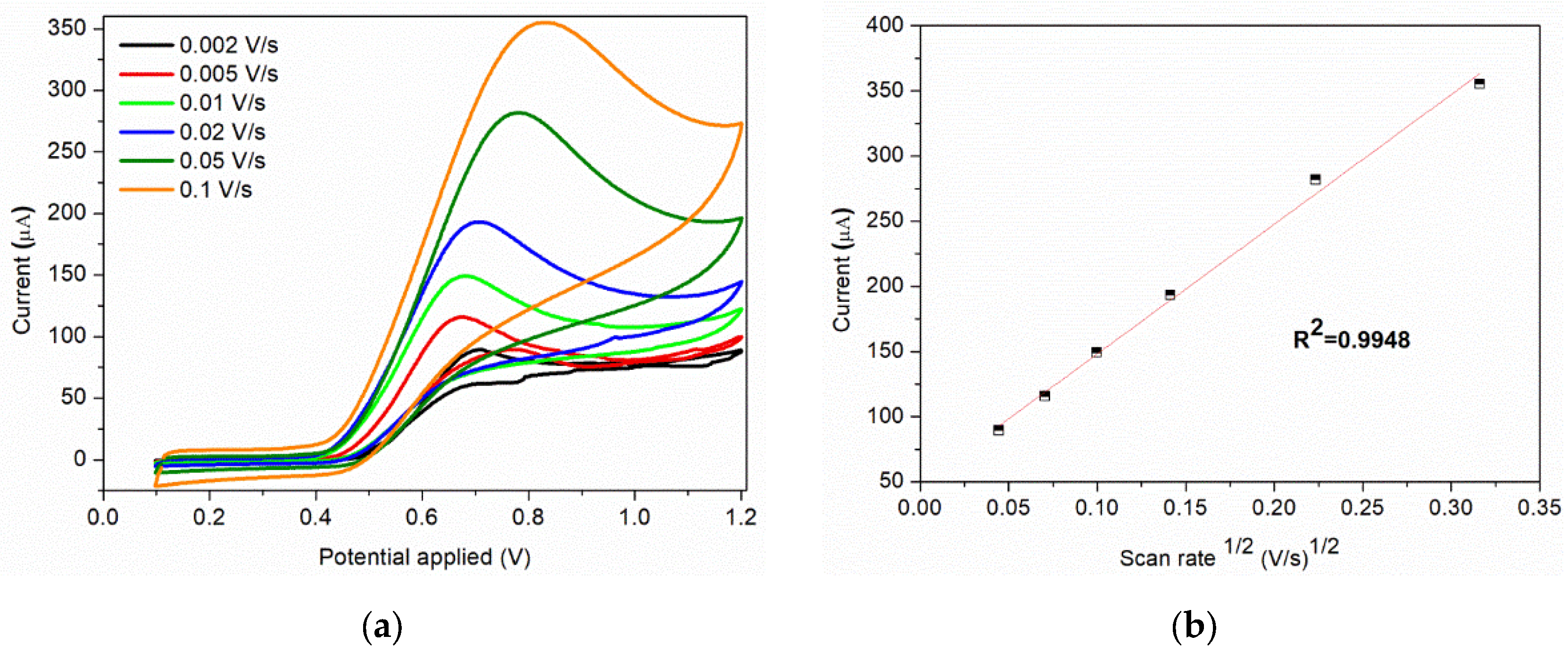


| Sample No. | Target Composition (wt %) in H2O |
|---|---|
| A | 15% CNT + 1% Chit + 1% C32H16FeN8 |
| B | 15% CNT + 1% Chit + 0.4% C32H16FeN8 |
| C | 22% CNT + 1% Chit + 0.4% C32H16FeN8 |
| D | 22% CNT + 1% Chit + 1% C32H16FeN8 |
| Sensors (Electrode) | Medium/pH | Linear Range (µM) | LOD (µM) | Selectivity | Reference |
|---|---|---|---|---|---|
| AuNPs/MWCNTs/CPE | BR/4.0 | 0.05–250 | 0.01 | Na+, K+, Mg2+, Ba 2+, Ca2+, Zn2+, Cl−, NO3−, SO42−, CO32−, ClO4−, PO43−, F− | [8] |
| PdNPs/MWCNTs/GCE | PBS */7.0 | 0.05–2887 | 0.022 | Ni2+, Ca2+, Mg2+, Fe2+, Zn2+, Co2+, Na+, Cl−, SO42−, SO32−, NO3−, CO32−, F− | [9] |
| Ag/Cu/MWCNTs/GCE | PBS/7.0 | 1–1000 | 0.2 | Cl−, NO3−, SO42−, K+, Ca2+ | [10] |
| Fe(III)P/MWCNTs/GCE | PBS/4.0 | 1–600; 600–1600 | 0.5 | NaCl, KCl, CaCl2, MgSO4, ZnCl2, Al(NO3−)3, Zn(NO3−)2, K2CO3, MnCO3, Mn(CH3COO)2, ZnCO3, glucose,α-lactose | [11] |
| Chit-AgNPs/MWCNTPE | BR/4.0 | 0.1–100 | 0.03 | Br−, PO43−, SO42−, S2−, I−, CH3COO−, Cl−, NO3− | [14] |
| Chit/CNs/MWCNTs/GCE | PBS/5.5 | 5–1000 | 0.89 | Na2SO4, CH3COOK, CaCl2, NH4NO3, CaI, CuSO4, glucose, citric acid, ascorbic acid | [15] |
| P2Mo17V-PSS-CNTs/Pt-Chit/ITO | PBS/6.0 | 0.25–4167 | 0.9 | C2H5OH, Na2SO4, KbrO3, Na2CO3, KCl, KNO3, glucose, acestic acid, citric acid | [16] |
| AuNPs/Chit/Ti3C2Tx/GCE | PBS/7.0 | 0.5–335; 335–3355 | 0.069 | NH4Cl, K2SO4, NaNO3, Na2SO3, K2CO3, Cu(NO3)2 | [17] |
| AuNPs/T i3C2Tx/ERGO/GCE | PBS/7.0 | 0.5–80; 80–780 | 0.15; 0.051 | NH4Cl, K2SO4, NaNO3, K2SO4, K2HPO4, KCl, Cu(NO3)2 | [18] |
| ssDNA/SWCNTs/GCE | PBS/4.0 | 0.6–540 | 0.15 | NaCl, K2SO4, Ca(NO3)2, glucose H2O2, Na2SO3, ascorbic acid, uric acid, KIO3, KI | [19] |
| Cu2+/DNA-SWCNTs/GCE | PBS/3.0 | 0.03–2600 | 0.03 | Na+, K+, Mg2+, Zn2+, Cu2+, Cl−, F−, NO3−, CH3COO−, C2O42−, CO32−, PO43− | [20] |
| CNT/Chitosan/C32H16FeN8 | BR/4.0 | 0.4–10 | 0.12 | NO3−, SO42−, S2O32, PO43−, CH3COO−, Cl− | This work |
| Added (μM) | Found (μM) | Recovery (%) | RSD (%) |
|---|---|---|---|
| 1 | 1.15 | 115.7 | 4.42 |
| 3 | 3.36 | 112.1 | 3.98 |
| 5 | 5.19 | 103.9 | 3.67 |
| 9 | 8.89 | 98.8 | 2.31 |
Publisher’s Note: MDPI stays neutral with regard to jurisdictional claims in published maps and institutional affiliations. |
© 2022 by the authors. Licensee MDPI, Basel, Switzerland. This article is an open access article distributed under the terms and conditions of the Creative Commons Attribution (CC BY) license (https://creativecommons.org/licenses/by/4.0/).
Share and Cite
Craciun, C.; Andrei, F.; Bonciu, A.; Brajnicov, S.; Tozar, T.; Filipescu, M.; Palla-Papavlu, A.; Dinescu, M. Nitrites Detection with Sensors Processed via Matrix-Assisted Pulsed Laser Evaporation. Nanomaterials 2022, 12, 1138. https://doi.org/10.3390/nano12071138
Craciun C, Andrei F, Bonciu A, Brajnicov S, Tozar T, Filipescu M, Palla-Papavlu A, Dinescu M. Nitrites Detection with Sensors Processed via Matrix-Assisted Pulsed Laser Evaporation. Nanomaterials. 2022; 12(7):1138. https://doi.org/10.3390/nano12071138
Chicago/Turabian StyleCraciun, Cristina, Florin Andrei, Anca Bonciu, Simona Brajnicov, Tatiana Tozar, Mihaela Filipescu, Alexandra Palla-Papavlu, and Maria Dinescu. 2022. "Nitrites Detection with Sensors Processed via Matrix-Assisted Pulsed Laser Evaporation" Nanomaterials 12, no. 7: 1138. https://doi.org/10.3390/nano12071138
APA StyleCraciun, C., Andrei, F., Bonciu, A., Brajnicov, S., Tozar, T., Filipescu, M., Palla-Papavlu, A., & Dinescu, M. (2022). Nitrites Detection with Sensors Processed via Matrix-Assisted Pulsed Laser Evaporation. Nanomaterials, 12(7), 1138. https://doi.org/10.3390/nano12071138








